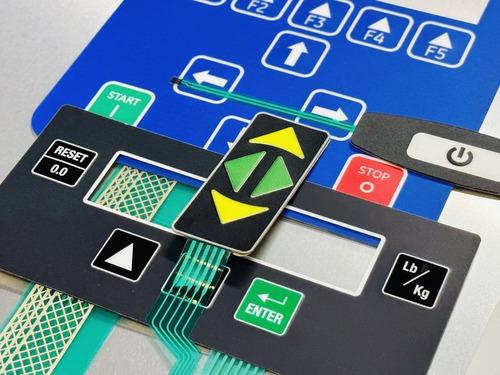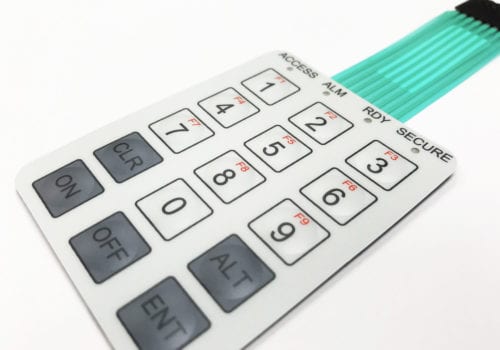Why Designers Select Membrane Switches for Their High Performance and Longevity
Why Designers Select Membrane Switches for Their High Performance and Longevity
Blog Article
Membrane Layer Switches Explained: A Comprehensive Overview to Their Advantages
Membrane changes represent a functional and advanced service for producing individual interfaces throughout a range of fields. As markets increasingly seek trusted and reliable control user interfaces, comprehending the details advantages and applications of membrane layer changes ends up being vital.
What Are Membrane Buttons?

When stress is related to the membrane layer button, the layers make contact, finishing an electrical circuit. This easy mechanism enables a wide variety of applications, from customer electronic devices to industrial equipment. Membrane switches are frequently designed to be waterproof and immune to dust and impurities, making them suitable for atmospheres where resilience is important.
Furthermore, the flexibility of the materials utilized in membrane switches assists in cutting-edge designs that can satisfy various forms and measurements. This adaptability adds to their popularity in varied areas, consisting of medical gadgets, automobile controls, and home devices. In general, membrane switches represent an essential aspect in modern interface modern technology, bridging the void in between individuals and electronic systems.
Trick Benefits of Membrane Switches
Among the myriad of interface choices offered, membrane switches stick out for their unique mix of benefits. Among the key advantages is their small and lightweight style, which enables assimilation right into a wide variety of tools without adding significant mass. This is especially helpful in applications where space is limited.
Additionally, membrane layer switches offer resilience and resistance to ecological elements. They are commonly created with products that can stand up to moisture, dirt, and various chemicals, making them ideal for harsh problems. This toughness adds to a longer life expectancy compared to conventional mechanical switches.
An additional substantial advantage is the flexibility in customization. Membrane buttons can be published with numerous graphics, shades, and structures, enabling tailored designs that meet details branding or functional demands. This flexibility expands to the variety of layers and circuit choices, giving engineers with several setups.
Furthermore, the responsive responses provided by some membrane layer changes improves user experience, making them much more intuitive to operate. Finally, the ease of cleansing and maintenance further strengthens membrane layer buttons as a functional selection in both consumer and commercial applications. Membrane Switches. In general, these key advantages make them a recommended option for many designers and suppliers
Applications in Different Industries
Just how do membrane layer switches locate their location throughout diverse sectors? Their convenience and functionality make them indispensable parts in fields varying from health care to consumer electronic devices. In clinical devices, membrane switches are utilized for their convenience of cleansing and resistance to contamination, guaranteeing health in environments where sterility is essential.
In the customer electronics sector, these switches provide streamlined, easy to use interfaces that improve product visual appeals while preserving resilience versus wear and tear. Automotive applications profit visit from membrane changes too, where they are used in control panels and control board, providing reputable efficiency in challenging problems.
Additionally, commercial machinery uses membrane buttons for control panels as a result of their toughness, capacity to hold up against rough environments, and customizable styles that satisfy details operational needs. The food industry leverages membrane layer switches for their convenience of usage and resistance to spills, making certain functional performance in hectic settings.
Eventually, the flexibility of membrane layer changes across these diverse applications emphasizes their crucial duty in modern-day innovation, improving individual communication while meeting industry-specific demands. Their proceeded advancement promises more assimilation into arising areas and innovative items.
Design and Personalization Alternatives
The design and modification choices offered for membrane layer switches are critical for customizing user interfaces to fulfill certain customer needs and aesthetic choices. These switches can be developed in various shapes, sizes, and layouts, enabling smooth assimilation right into varied applications. The flexibility in design means that suppliers can produce one-of-a-kind user interfaces that enhance functionality and preserve brand identity.
Customized shades, textures, and graphics can be related to the surface area of the membrane switch, giving a possibility for branding and individual involvement. Additionally, backlighting choices, such as LED illumination, can be integrated to boost visibility in low-light conditions, hence boosting functionality.
Useful components can additionally be tailored, consisting of responsive feedback and actuation force, which can be readjusted to suit different individual communications. The choice of materials, such as polyester or polycarbonate, allows for variants in toughness and environmental resistance, dealing with the particular needs of different markets.
Ultimately, the extensive layout and customization abilities of membrane buttons allow companies to produce aesthetically enticing and user-friendly interfaces, guaranteeing that their items meet both visual and useful needs efficiently. Membrane Switches.
Factors To Consider for Implementation
Carrying out membrane layer switches needs mindful consideration of numerous variables to guarantee ideal capability and user experience. Factors such as exposure to wetness, severe temperature levels, and chemical materials can considerably influence the button's performance and longevity.

An additional essential facet is the button's style and layout. Making sure that the tactile responses and actuation pressure straighten with individual expectations improves use. Carrying out user screening can supply valuable understandings into the optimum style.
Furthermore, compatibility with electronic components need to be analyzed. The switch's wiring should line up with the general system style, guaranteeing trustworthy signal transmission and lessening disturbance.
In addition, manufacturing techniques and expenses ought to be examined. The option in between custom layouts and conventional models can lead and influence both spending plan time.
Last but not least, consider repair and maintenance. Membrane buttons may call for certain cleaning and care treatments to preserve their look and performance in time. By attending to these considerations, companies can execute membrane layer switches that meet their functional requirements while offering a favorable individual experience.

Verdict
Finally, membrane layer switches stand for a long lasting and versatile control user interface appropriate for a vast array of applications across numerous industries. Their compact style, resistance to ecological aspects, and customizable functions boost read what he said customer experience while redirected here meeting details branding requirements. As technology remains to advance, the relevance of membrane layer buttons in contemporary tools remains considerable, offering both performance and visual appeal. Future improvements will likely better broaden their applications and performance in various atmospheres.
Membrane changes represent a advanced and versatile option for producing individual interfaces throughout a range of sectors.Comprehending the essential elements of contemporary electronic interfaces, membrane switches are a type of customer interface tool that consist of versatile, thin layers of product. In general, membrane changes represent a crucial component in contemporary individual interface innovation, connecting the space between users and digital systems.
Among the myriad of user interface options available, membrane layer switches over stand out for their special combination of advantages.The style and modification options offered for membrane buttons are crucial for tailoring user interfaces to meet specific customer needs and visual preferences.
Report this page